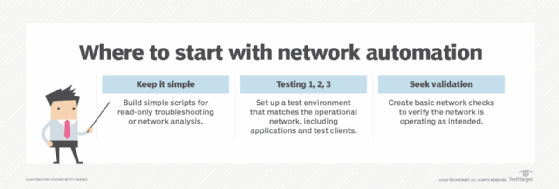
kentoh - Fotolia
Benefits of network automation software ease challenges for IT
Network automation software comes with a compelling list of benefits, but IT teams should confirm which processes are automated and how the software integrates with existing tools.
Networks in most organizations continue to grow more complex and challenging to deploy, operate and maintain. New network automation tools use advances in software networking to reduce manual processes in the network and address network complexity.
Network automation is a broad category of tools and processes designed to eliminate manual network tasks, such as provisioning, scripting, implementing change requests, and identifying causes of slowdowns and outages. The benefits of network automation software include the replacement of manual processes via software configuration, zero-touch provisioning, network management and testing capabilities.
Increased network complexity drives the need for automation
Modern networks contain a dizzying array of hardware and software products, including cabling, Ethernet switches, Wi-Fi access points and controllers, routers, application delivery controllers, software-defined WAN and network security gear -- most of which is from multiple suppliers. Each network location -- i.e., data center, campus or branch -- has its own unique architecture and set of products and suppliers. The addition of software-defined networking into this mix has generally increased the complexity.
The vast majority of network tasks are still manual, including adds, moves and changes to the network or security. Identifying the cause of application slowdowns, brownouts or outages is akin to finding a needle in the haystack -- and it's often just as time-consuming. Further, topologies and other sources of network information are often located in multiple databases, which makes it challenging for IT personnel to find the real network map.
Benefits of network automation software
Network automation software can provide several benefits to IT organizations. It is designed to reduce or eliminate various repetitive, manual tasks that are often labor-intensive, such as provisioning, configuration changes and policy implementation. Other benefits of network automation software include the following:
- reduced chance of human errors, which affect network performance and security;
- rapid provisioning of new services, including centralized zero-touch provisioning at remote locations;
- ability to locate and identify the root cause of network or security issues; and
- reduced security risk, as fewer manual processes means fewer configuration or policy errors that can open the network to attack.
Overall, network automation software can improve network availability and make the network easier to deploy and less labor-intensive to operate.

Network automation requirements
IT teams should carefully evaluate network automation options regarding the specific benefits they bring to the network. Some key questions include the following:
- What specific network processes are being automated?
- Is the software applicable to your multivendor network?
- Does the software fit only one part of the network -- e.g., data center -- or work across campus and branch networks as well?
- Is the software integrated with network security tools?
Network automation software should be easy to learn, implement and use. It should be able to work well with existing management systems and to integrate with IT service management and orchestration technologies.
What about AI and machine learning?
AI and machine learning are two buzzwords typically used when discussing the future of network automation. Network management systems can learn from large data sets and provide improved insight about problem resolutions.
However, the industry is a long way from developing network products that can run themselves. Multiple network and security product types spread across data centers, campus and branch locations will continue to drive network complexity. Doyle Research advises IT professionals to be skeptical of vendor claims around network automation driven by AI and machine learning.
Network automation vendors to watch
Network automation software comes in many shapes and sizes. Specific products may address relatively narrow issues or provide broad automation capabilities.
Network automation software suppliers include Anuta Networks, Aruba Networks, Aviatrix, Cisco, Forward Networks, Gluware, NetBeez and ThousandEyes, among others.








